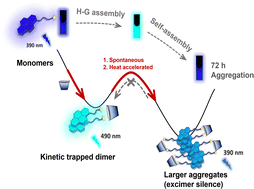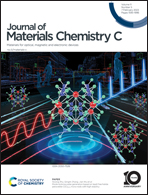A time-resolved and visualized host–guest self-assembly behavior controlled through kinetic trapping†
Abstract
Developing visible approaches to real-time monitoring of kinetic traps within the thermodynamic equilibrium process is of great importance for fundamental research into dynamic supramolecular chemistry. Herein, we have designed a dynamic supramolecular system fabricated with host–guest recognition between pyrene derivatives (Py-TMA) and p-sulfonatocalix[4]arenes (SC4) in aqueous solution. Significantly, the emission color of Py-TMA spontaneously changed from indigo blue (from the monomer) to cyan (from the excimer) after assembly with SC4, and unaccustomedly gradually returned to the original indigo blue within 72 h. Our research demonstrated that the above subtle optical variation was an excimer on/off process involved a kinetic-trapped state in a host–guest assembly. Besides, combined with the cationic energy acceptor ethidium bromide (EB), a dynamic and time-variant artificial-light-harvesting system was successfully fabricated and presented a red-to-blue emission color change with an energy transfer efficiency of up to 99%. Our study offers a visual and spontaneous approach to monitoring the macroscopic self-assembly dynamic process and demonstrates the complexity existing in supramolecular self-assembly, especially for host–guest counterparts in which only the thermodynamic state is commonly addressed.

- This article is part of the themed collection: 2023 Journal of Materials Chemistry C HOT Papers


 Please wait while we load your content...
Please wait while we load your content...